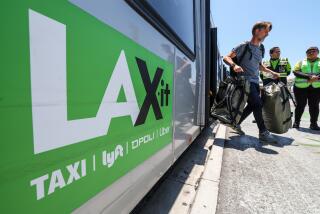There’s No Curbing Van and Cab Fare War at Burbank Airport
- Share via
East and West Germany are unified. North and South Korea are talking about talking again. And even the Irish Republican Army is shelving its bombs, for now.
So, when will peace come to Burbank Airport, where feuding cabbies and shuttle van drivers have for years exchanged nasty glares, disparaging remarks and the occasional knuckle sandwich?
At the root of this long-running rivalry is a dispute over who gets to work the curb closest to the terminal and, thus, has first shot at arriving airline passengers, the bread and butter of these working-class chauffeurs.
This is no small matter. Cabbies and van drivers work long hours, with most of their income going to gasoline, insurance and the cab companies. The few extra fares they can get due to better access is the difference between a steak and good whiskey at the end of the day or cold baloney and watery beer.
It’s a dog-eat-dog world out there and these drivers are fighting for every bone.
But to understand the turf war, it is important to know the turf. In front of the terminal’s main exit, there are four median islands that run parallel to the building. The first island has a white curb, which everybody knows is only for loading and unloading passengers--from private cars. The next island--with the coveted curb--is controlled by the shuttle vans, under a decree by airport management. The cabbies share the third island, behind the vans and about 50 yards from the terminal. And the last island is for the free hotel shuttle vans.
This arrangement ticks off the taxi drivers, who contend they are losing business to the shuttle vans because passengers leaving the terminal see the vans first. There they are, the cabbies complain, hidden away behind a Berlin Wall of shuttle vans, cast into unprofitable outer darkness.
“It’s just not right,” fumed taxi driver Razmik Asaturyan as he cooled his heels at the taxi island. “Everywhere else in the country--Washington, New York--the first curb is for taxis.”
Some van drivers don’t see what all the fuss is about. Sure, they have better access to passengers, they say, but most of their business comes from passengers with reservations anyway. They call the complaints sour grapes.
“The taxis resent us because they’ve been here for a long time and then the shuttles come along recently and get a piece of the pie,” said Larry Clement, who supervises the vans at the airport for a major shuttle line.
Clement has seen the rivalry between the two sides heat up, even resulting in fistfights.
But it wasn’t always like this. About a year ago, the cabbies happily controlled the first island while the second was set aside for vans. The van drivers, of course, hated that.
Airport officials moved the cabbies to the third island, setting aside the first island for private cars.
That was not supposed to give one side an advantage over the other, say airport officials, who deny there is any rivalry.
Don’t tell that to taxi driver Alex Vaktorian. He said cabbies are losing fares to the vans, especially elderly and disabled passengers who would rather not walk the extra few yards to the taxis’ island.
“In all the airports all over the world, the taxis are first except for here,” he said, his voice filled with frustration.
But the gripes extend beyond the dispute over curb space.
The two sides also grumble about a longstanding rule that forbids both taxi and van drivers from verbally soliciting passengers as they leave the terminal and approach the medians. Each group accuses the other of violations.
But the rule is difficult to enforce. If a driver asks, “You need a cab?” who’s to say if that’s a helpful query or verboten huckstering, punishable by a fine.
They also say it’s unclear if it violates the rule to ask such a question of a passenger who has come to their median. Must they remain silent even if a prospective passenger seems to be looking for their services?
In addition, the airport instituted new rules last year requiring van drivers to park in a waiting area on the outskirts of the airport until a passenger notifies a shuttle supervisor at the curb that they need a van. Only then can the van drivers pull up to the curb.
No such rule applies to taxis, who can park at their curb any time, as long as they don’t overflow the allotted space. Cabs pile up there, misleading passengers who see only the taxis into thinking they are the sole option, complained Gustavo de Obaldia, a five-year shuttle van veteran.
To solve this problem, De Obaldia asked airport officials to allow at least one van--a “show van”--to sit at the shuttle drivers’ curb to generate interest, but they rejected his plea, he said.
As a group of taxis waited for fares and complained about their lot in life recently, two women trudged up to the front of the line pulling an overloaded luggage cart. Suddenly, one of them lost control of the cart, sending it crashing against a parked cab.
The collision left a four-inch scratch on the taxi’s front panel, evoking a protest from the driver, who insisted the women pay for the damage.
Ignoring his complaints, they suggested that in this life, stuff happens. Then they piled into another cab and vanished.
“See,” the cabby griped, “this is part of the problem because people have to walk all this way” to get a cab.
OK, maybe the logic isn’t impeccable, but his drift is clear.
Those last few feet.
One small step for passengers; one big battleground for drivers.
More to Read
Sign up for Essential California
The most important California stories and recommendations in your inbox every morning.
You may occasionally receive promotional content from the Los Angeles Times.














